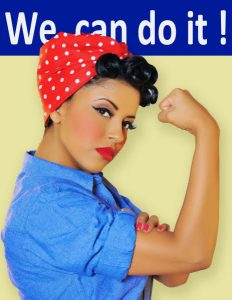 In March, we celebrate Women’s History Month and the amazing women who have made America great – Sally Ride, the first female in space; Rosa Parks; and many “hidden figures” who have cracked the glass ceiling. This year, that celebration builds upon the visible symbols of women’s unity at January’s Women’s March and the “A Day Without a Woman” event on March 8th. But, marching alone isn’t enough to improve the lives of women across the country. We must also rally together every day to chart a path forward for all women seen and unseen.
In March, we celebrate Women’s History Month and the amazing women who have made America great – Sally Ride, the first female in space; Rosa Parks; and many “hidden figures” who have cracked the glass ceiling. This year, that celebration builds upon the visible symbols of women’s unity at January’s Women’s March and the “A Day Without a Woman” event on March 8th. But, marching alone isn’t enough to improve the lives of women across the country. We must also rally together every day to chart a path forward for all women seen and unseen.
Let’s start first with the data – the Institute for Women’s Policy Research does a fantastic job of compiling data and synthesizing it in compelling ways. In particular, their state-by-state comparison is a powerful tool to see how your state stacks up in a number of different social and economic factors impacting women. Here is a sampling of the most compelling national statistics and why they should be important to everyone:
- Poverty: 1 in 3 American women, 42 million women, plus 28 million children, either live in poverty or on the brink of it.
- Childcare: Two-thirds of American women are either the primary or co-breadwinners of their families. In the United States, the average annual cost of childcare to families ranges from $5,496 in Mississippi to $16,549 in Massachusetts, which translates to 29 to 56 percent of median annual income for single mothers. Reliable child care makes the difference for working moms by reducing absenteeism, which costs employers, and helping reduce gaps in employment for women, which impacts their income.
- Higher Education: Women earn more with every step up in their education. However, we know that women, especially Hispanic and African American women, face greater barriers to graduation – social stigma, poverty and the costs of education – which cause them to forgo higher education.
- Health Insurance: Women with quality health care go farther – they live longer, use fewer sick days, have higher quality of life and contribute more to our communities. Yet, 11 percent of women and girls in the United States do not have health insurance, which puts all of this at risk.
- Housing: For many women, housing represents the single largest cost in their budgets. Ideally, housing should cost less than 30 percent of their total budget, but almost half of families where females are the primary breadwinner pay more than 30 percent of their income on housing. This makes it nearly impossible for them to invest in education, provide for their children or contribute to retirement.
For many women, the American dream remains elusive as they try to balance being great mothers, working hard as employees and taking care of others before themselves. Their struggles not only weigh them down, but they also curb the growth of our economy as a whole.
So, what can be done? While the statistics are a bitter pill to swallow, nonprofits across the country are working hard to beat these numbers and work toward solutions. Here is a snapshot of the most effective models and programs that are helping women rise above poverty and toward self-sufficiency:
- Working Families Success model delivers a “bundled” set of three core services (employment services, income support and financial coaching) with the goal of helping clients on a journey toward self-sufficiency. In measuring the model’s success, research has shown that clients who receive two or more services together are three to four times more likely to achieve a major outcome.
- Two Generation programs create opportunities to address needs of both vulnerable parents and children together. Even though the 2Gen field is still developing, early results suggest that this approach is making great strides. It has four essential components: education (i.e., early childhood education, postsecondary and employment pathways), economic supports, health and well-being, and social capital.
- First Generation College programs are heavily focused on a comprehensive approach that breaks down barriers related to academic preparation and financing. Services are generally not piecemeal; rather, students receive support in all areas of the ecosystem: academic, financial and supportive.
- Bridges Out of Poverty challenges us to think through a triple lens – individual, institution and community. It helps with shifting how we view poverty, understand why individuals stay stuck and how our systems can be redesigned to better support movement out of poverty.
While statistics can be daunting, progress for women has been made in the past and will continue to be made through the collective action we take for a better tomorrow. So, as women, let’s march, but let’s also sign up to help a nonprofit in our community turn these statistics around. We’d love to hear about ways you’re helping to improve the lives of women in your community.
